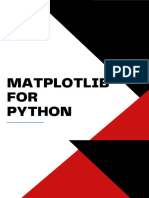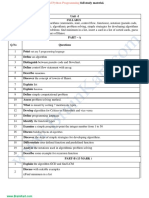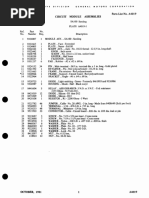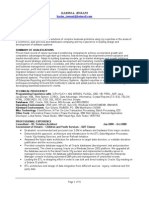Python Data Structures Cheat Sheet
Uploaded by
Manju DeviPython Data Structures Cheat Sheet
Uploaded by
Manju DeviDATA STRUCTURES
Average
Lists and Tuples in Python Algorithm Best case
case
Worst case Remarks Dictionaries
Selection n exchanges,
Ordered sequence of values indexed by integer numbers. Tuples are immutable ½n2 ½n2 ½n2 It is an unordered set of key value pairs
sort quadratic is the best case
CHEAT SHEET
• To specify size of tuple/list: • Initialize an empty Dict
Insertion Used for small or partial-
• To initialize empty list /tuple: n ¼n2 ½n2 Syntax: myDict = {}
Synatx: len(myListOrTuple) sort sorted arrays
Syntax: Lists: myList = [] • Add an element with key "k" to the Dict
• Remove element in position X of list/tuple: Rarely useful,
Tuples: myTuple = () Bubble Syntax: myDict["k"] = value
n ½n2 ½n2 Insertion sort can be used
• To get an element in position x in list/tuple: Syntax: Lists: del myList[x] sort • Update the element with key "k"
Python - Data Structure Syntax: "x" in myListOrTuple
•
Tuples: tuples are immutable!
Concatenate two lists/tuples:
instead
Tight code,
•
Syntax: myDict["k"] = newValue
Get element with key "k"
Shell sort n log3 n unknown c n 3/2
• Index of element ‘X’ of list/tuple Sub quadratic
Lists: myList1 + myList2 Syntax: myDict["k"] -- If the key is not
Syntax: myListOrTuple.index("x") - Merge n log n guarantee; present, a KeyError is raised
Tuples: myTuple1 + myTuple2 ½ n lg n n lg n n lg n
Data Types - If not found, throws a ValueError
Concatenating a List and a Tuple will
sort stable • Check if the dictionary has key "k"
exception n log n probabilistic
produce a TypeError exception Syntax: "k" in myDict
It is a way of organizing data that contains the items stored and their Quick sort n lg n 2 n ln n ½n2 guarantee;
• Number of occurance of X in list/tuple: • Get the list of keys
relationship to each other • Insert element in position x of a list/tuple fastest in practice
Syntax: myListOrTuple.count("x") Syntax: myDict.keys()
The areas in which Data Structures are applied: Syntax: Lists: myList.insert(x, n log n guarantee;
Heap sort n† 2 n lg n 2 n lg n • Get the size of the dictionary
• Compiler design Data structures can be used in • Update an item of List/tuple: "value") in place
Syntax: len(myDict)
• Operating system the following areas: Syntax: Lists: myList[x] = "x“ Tuples: tuples are immutable!
Worst Case Average Case • Delete element with key "k" from the dictionary
• Database Management System • RDBMS: Array ( Array of • Append "x" to a list/tuple:
Tuples: tuples are immutable! Syntax: del myDict["k"]
structure) Data Structure Search Insert Delete Search Insert Delete
• Statistical Analysis Package Syntax: Lists: myList.append("x")
• Remove element in position X of list/tuple: • Delete all the elements in the dictionary
• Numerical Analysis • Network data model: Tuples: tuples are immutable!
Sequential
n n n n n n Syntax: myDict.clear()
Graph Syntax: Lists: del myList[x] search
• Graphics • Convert a list/tuple to tuple/list:
• Hierarchical Data model: Tuples: tuples are immutable! Binary search log n n n log n n n
• Artificial Intelligence Syntax: List to Tuple: tuple(myList)
• Simulations Trees Binary search
Tuple to List: list(myTuple) n n n log n log n sqrt(n)
tree Data Structures
Red-black BST log n log n log n log n log n log n
Types of Data Structures Hash table n n n 1† 1† 1†
Primitive Data Structures: Non- Primitive Data Structures: 1 † - Uniform hashing assumption
• Array: It is a compact way of collecting data types where all entries must be of the same Non -
• Integer: It is used to represent numeric data, more specifically whole numbers Primitive
from negative infinity to infinity. Eg: 4, 5, -1 etc
data type. Sets Primitive
Syntax of writing an array in python:
• Float: It stands for floating point number. Eg: 1.1,2.3,9.3 etc import array as arr It is an unordered collection with no duplicate elements. It supports mathematical operations like
• String: It is a collection of Alphabets, words or other characters. In python it a = arr.array("I",[3,6,9]) union, intersection, difference and symmetric difference.
type(a) •
can be created by using a pair of single or double quotes for the sequence. • To initialize an empty set: Union of two sets Integer Float String Boolean
• Linked list: List in Python is used to store collection of heterogeneous items. It is
Syntax: mySet = set() Syntax:
Eg: x = 'Cake’ described using the square brackets [] and hold elements separated by comma
Method 1: mySet1.union(mySet2)
y = '’Cookie’’ Eg: x = [] # Empty list • Initialize a non empty set
Method 2: mySet1 | mySet2 Array List Tuple Dictionary Set File
type(x) Syntax: mySet = set(element1,
Certain operations can be performed on a string:
o The list can be classified into linear and non-linear data structures • Intersection of two sets
element2...)
o Linear data structures contain Stacks and queues Syntax:
o We can use * to repeat the string for o To capitalize the strings • To add element X to the set
a specific number of times. Eg: x*2 o Non-linear data structures contains Graphs and Trees Method 1:
Eg: str.capitalize('cookie') Syntax: mySet.add("x") Linear Non - Linear
• Stack: It is a container of objects that can be inserted or removed according to LIFO(Last mySet1.intersect(mySet2)
o String can be sliced, that is to select
o To retrieve the length of the strings In First Out) concept. pop() method is used during disposal in Python • Remove element "x" from a set: Method 2: mySet1 & mySet2
parts of the string. Eg: Coke Eg: stack.pop() # Bottom -> 1 -> 2 -> 3 -> 4 -> 5 (Top)
Eg: Syntax: • Difference of two sets
z1 = x[2:] stack.pop() # Bottom -> 1 -> 2 -> 3 -> 4 (Top) Method 1: mySet.remove("x") -- Syntax: Stacks Queues Graphs
str1 = "Cake 4 U" print(stack) Trees
print(z1) If "x" is not present, raises a Method 1:
• Queue: It is a container of objects that can be inserted or removed according to
str2 = "404" KeyErorr mySet1.difference(mySet2)
# Slicing FIFO(First In First Out) concept.
len(str1) Method 2: mySet.discard("x") -- Method 2: mySet1 - mySet2
• Graph: It is a data structure that consists of a finite set of vertices called nodes, and a
z2 = y[0] + y[1]
finite set of ordered pair (u,v) called edges. It can be classified as direction and weight Removes the element, if present • Symmetric difference of two sets
o To replace parts of a string with
print(z2) • Binary Tree: Tree is a hierarchical data structure. Here each node has at most two • Remove every element from the set Syntax:
another string
children Syntax: mySet.clear() Method 1:
Output: ke
o Eg: str1.replace('4 U', • Binary Search Tree: It provides moderate access/ search and moderate insertion/ • Check if "x" is in the set mySet1.symmetric_difference(m
Co str2) deletion Syntax: "x" in mySet ySet2)
• Boolean: It is a built-in data type that can take the values TRUE or FALSE • Heap: It is a complete tree and is suitable to be stored in an array, It is either MIN or Max • Size of the sets:
• Hashing: Collection of items that are stored in a way that it becomes easy to find them is
Method 2: mySet1 ^ mySet2
FURTHERMORE:
Syntax: len(mySet)
hashing Data Structures Certification Training Course
You might also like
- Python Programming Exercises Gently Explained88% (8)Python Programming Exercises Gently Explained160 pages
- 15 Essential Python Interview Questions: Data Structures Primitive Types The Heap100% (1)15 Essential Python Interview Questions: Data Structures Primitive Types The Heap144 pages
- Python Interview Questions and Answers (2021) - InterviewBitNo ratings yetPython Interview Questions and Answers (2021) - InterviewBit26 pages
- Python Interview Questions: Answer: in Duck Typing, One Is Concerned With Just Those Aspects of An Object That AreNo ratings yetPython Interview Questions: Answer: in Duck Typing, One Is Concerned With Just Those Aspects of An Object That Are12 pages
- Python Cheat Sheet: Print Print ("Hello World") Input Input ("What's Your Name")100% (1)Python Cheat Sheet: Print Print ("Hello World") Input Input ("What's Your Name")16 pages
- Scripting PYTHON Programming Lab Manual by M Murali Mohan ReddyNo ratings yetScripting PYTHON Programming Lab Manual by M Murali Mohan Reddy25 pages
- Question Bank-Problem Solving and Python ProgramNo ratings yetQuestion Bank-Problem Solving and Python Program13 pages
- Python-Programming-Exercises - 100+ Python Challenging Programming Exercises100% (2)Python-Programming-Exercises - 100+ Python Challenging Programming Exercises33 pages
- Python3: Introduction To Python3 Programming Language100% (1)Python3: Introduction To Python3 Programming Language81 pages
- Python Loop Statement: By: Abhishek Saikia Class: 12 (C) Roll No: 17No ratings yetPython Loop Statement: By: Abhishek Saikia Class: 12 (C) Roll No: 1712 pages
- Python Lab Manual by R.Nakkeeran For JNTUH Python Syllabus100% (1)Python Lab Manual by R.Nakkeeran For JNTUH Python Syllabus45 pages
- Python Parallel Programming Cookbook - Sample Chapter67% (3)Python Parallel Programming Cookbook - Sample Chapter39 pages
- Ch05 - Python - Data Structures - 1721754633No ratings yetCh05 - Python - Data Structures - 172175463337 pages
- 2_Lists_and_Tuples__1___5__lyst1729231893012No ratings yet2_Lists_and_Tuples__1___5__lyst17292318930127 pages
- HTET Question Paper Nov 2016 Level 3 PGT Computer Science PDFNo ratings yetHTET Question Paper Nov 2016 Level 3 PGT Computer Science PDF32 pages
- Haryana Employment Exchange - Welcome To Haryana Employment Exchange, Haryana PDF0% (1)Haryana Employment Exchange - Welcome To Haryana Employment Exchange, Haryana PDF2 pages
- Present Simple Vs Present Continuous 1st EsoNo ratings yetPresent Simple Vs Present Continuous 1st Eso1 page
- Particle Swarm Optimization: Technique, System and ChallengesNo ratings yetParticle Swarm Optimization: Technique, System and Challenges9 pages
- An Analytical Study of Communication Protocols Used in Automotive IndustryNo ratings yetAn Analytical Study of Communication Protocols Used in Automotive Industry7 pages
- CISSP Exam Outline English April 2021 PDFNo ratings yetCISSP Exam Outline English April 2021 PDF16 pages
- Samsung Portable SSD T7 Shield User Manual English Ver 1.1No ratings yetSamsung Portable SSD T7 Shield User Manual English Ver 1.127 pages
- Read Allegations Against Daniel Harris From Sentencing PaperworkNo ratings yetRead Allegations Against Daniel Harris From Sentencing Paperwork31 pages
- A Naturalistic Study of Child and Family Screen Media and Mobile Device UseNo ratings yetA Naturalistic Study of Child and Family Screen Media and Mobile Device Use10 pages
- Questions & Answers PDF: C - THR81 - 2011No ratings yetQuestions & Answers PDF: C - THR81 - 20116 pages
- Slow Internet Connection Affecting Online Class100% (1)Slow Internet Connection Affecting Online Class4 pages






























































































